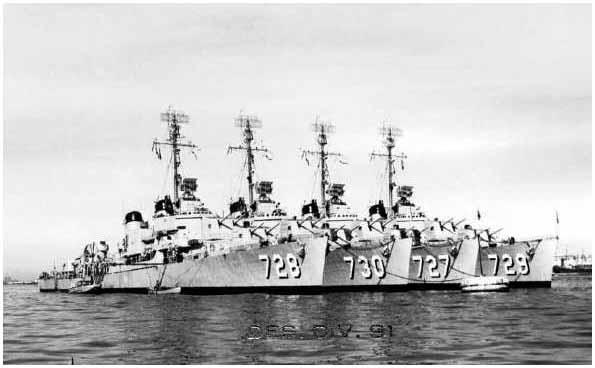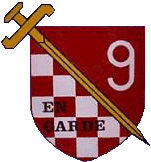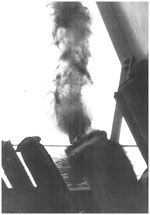
Such was the case with the MANSFIELD. She returned again to the Far East as part of the Seventh Fleet from March 1946 to February of 1947. After performing patrol duties along the Chinese, Korean and Japanese coasts she steamed home to San Diego.

 For the next two and one-half years, she trained both her own crew and reservists from the west coast and made annual cruises to the Western Pacific as part of Cruiser destroyer Force Pacific Fleet. MANSFIELD was flag ship for Destroyer Squadron Nine: the DeHaven (DD727), Lyman K. Swenson (DD729) and Collett (DD730).
For the next two and one-half years, she trained both her own crew and reservists from the west coast and made annual cruises to the Western Pacific as part of Cruiser destroyer Force Pacific Fleet. MANSFIELD was flag ship for Destroyer Squadron Nine: the DeHaven (DD727), Lyman K. Swenson (DD729) and Collett (DD730).
On 1 May 1950, Destron9 departed San Diego for duty in the Far East, Arriving 31 May at Yokosuka, Japan. After replenishment and several days stay, Desron9 deployed to Sasebo, Japan.
On 26 June, one day after North Korean forces invaded South Korea, MANSFIELD and Desron9, steamed from Sasebo to South Korea to rendezvous with evacuation vessels from Inchon. Beginning 27 June, the destroyers provided blockade, shore bombardment and escort services along the enemy coast of Korea until 8 September 1950.

Five US Navy destroyers steam up the Inchon Channel for the bombardment of Wolmi Do Island, on 13 Sept 1950. Note smoke rising from proceeding air strikes on the island. The ships are USS MANSFIELD (DD-728), DEHAVEN (DD-727), LYMAN K. SWENSON (DD-729), COLLETT (DD-730) AND GURKE (DD-783).
Go here for more details on MANSFIELD's role in the Inchon Invasion.
The morning of 13 September, as a unit of the United Nations invasion force en route from Sasebo to Inchon, six destroyers, led by MANSFIELD, with DeHaven, Swenson, Collett, Gurke and Henderson, were directed on a reconnaissance in force: attack to discover the position and strength of the enemy.
They broke for the main task group, seven to ten miles southwest of Inchon, and nosed single file, 700 yards apart, slowly up the narrow Flying Fish Channel into Inchon Harbor.Ordered to anchorages in the harbor close to Wolmi-Do Island, and expose itself, openly inviting enemy shore batteries on island open-fire, for the purpose of locating their gun positions; Desron9 won the appropriate title, "the Sitting Duck Squadron".
Their job, which they shared with the air attack element, was to knock out selected targets, principally enemy batteries along the sea wall and some emplacements on the hills of the city. Once the enemy guns on the island began firing, MANSFIELD and the other destroyers smothered them with a near point-blank barrage.
During the intense ship-shore artillery duel, the Collett received five hits by counter fire, sustaining considerable damage and wounding four of her men. Enemy shells hit the Gurke three times, wounding two men, but caused no serious damage to the ship. The Swenson suffered two casualties from a near miss: one was Lt.(jg) David H. Swenson, nephew of the officer for whom the ship was named. He was the only American killed during the assault. During the 48-minute battle a total of 25 shell geysers were observed all around the MANSFIELD. Five were close aboard, but somehow, miraculously, she was no touched.
A second reconnaissance in force, was carried out on 14 September, similar to the previous day. MANSFIELD proceeded up the channel in the lead of the destroyer unit, passing Wolmi-Do without incident. They did however, fire upon and destroy more gun emplacements on the beach, and in the hills of the city.
The next approach to the target area was made early on D-Day the 15th September. MANSFIELD, again leading the entire invasion fleet, dropped anchor during early morning darkness in the innermost berth in Inchon Harbor, firing on visually selected targets along the waterfront prior to the landing of troops. Later that morning, 34-minutes after the first landing wave arrived on Wolmi-Do, the island was reported secured.
Go here for more Korean conflict details.
For their gallantry, the six destroyers received the Navy Unit Commendation and the Korean Presidential Unit Citation.
Click ribbon ![]() for unit citation and newspaper report.
for unit citation and newspaper report.
Two weeks after Inchon, MANSFIELD, while searching for a downed Air Force B-26 bomber, struck a mine which served the bow below the main deck. The ship's casualties totaled twenty-eight, nine of whom required transfer to the cruiser Helena for surgical treatment and later to a hospital. After making her way to dry dock in Sasebo, and receiving a stub bow, she steamed to the Naval Shipyard at Bremerton, Washington, for major repairs and bow replacement. She rejoined the United Nations Fleet again, off South Korea late in 1951 for gun fired support escort, and shore bombardment duty.
Go here for full details of this incident.
"I was only on the Mansfield (TAD) from, mid-December '51 until mid-January '52. When I left, my orders were signed by a "MacMillan". I don't recall anyone in particular. We were regularly engaged by shore batteries fired from caves in the hills surrounding Wonsan harbor. We were supporting minesweepers clearing the Slot - a firing area near the coast from which 5" guns could reach the railroad yards in town. We also supported a detachment of the 41st Royal Commandos based on a small islet close to the mainland." - Lt(jg) Jerry Krupp

On 9 November 1952, the Mansfield encountered a floating mine and sank same. For details of this event, please go here.
After Korea, MANSFIELD alternated between duty in the Western Pacific and training west coast reservists. She was overhauled in the fall of 1955 at the Naval Shipyard, Long Beach, California.
From May 1958-Aug. 1958, MANSFIELD, as part of Joint Task Force 7.3 participated in Operation Hardtack 1. This was a series of nuclear tests held in the Pacific testing area. For more details go here .
According to shipmate Larry Lawton, "The MANSFIELD departed 17 July 1959 for WestPac. We were there with the Collett, DeHaven and Benner. Lifeguard for the Lexington, Taiwan patrol, etc." Larry adds, "Do you recall the radio call sign of the MANSFIELD? TACTICS."
To read messages describing this deployment go here .